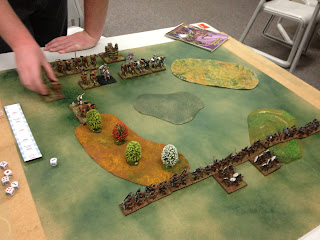I'm still reading through HiLo Heroes and pondering whether I will give it a try this weekend. If nothing else it's inspiring me to consider tinkering with Supercrew again; I'm fickle like that.

Here's a full character writeup, with stats for both games. It was a character I used in a PBEM game of 'Supercrew' on RPG.net a couple of years ago. She was originally a Champions character, but her stats for that game are lost.
Centennial City was the US city in which the campaign was set.
TESSERACT
(Jocasta Thorington)
Background and History
Jocasta Thorington is an 27 year-old English freelance journalist who came to Centennial City on holiday and never left. She met a girl, and fell in love. The usual story.
Her speciality – some would say obsession – is with the paranormal. Odd happenings, ghosts, UFOs and the unexplained draw her like a moth to a flame. With her partner, Roslyn Legler, she now runs ‘The Centennial Investigator’, a magazine devoted to the paranormal. It pays the bills, but not much more than that.Jocasta and Roslyn investigated things together, until the fateful day when a ghost story led them to an abandoned hotel which was the site of meeting between two local drug-lords. There was a hail of bullets. In her panic Jocasta found herself seeing the word in a new way – one with more dimensions. She avoided injury merely by becoming, well, flat. Then, grabbing hold of Roslyn she added an extra dimension, and simply stepped out of the room they were in and onto the street outside without passing through the intervening space. She was shaken, but unhurt. Roslyn wasn’t so lucky. She’d been hit and was badly wounded. She lived, but would never walk again.
Jocasta tracked down the people who had shot the person she cared about most in the world. Pushed to it, she couldn’t find it in herself to seriously hurt them, but her abilities enabled her to subdue them and turn them over to the authorities. She slipped away before any questions were asked; somehow she felt that it was best if Jocasta Thorington, with her questionable residencey status, wasn’t associated with these weird powers. But the weird powers could be used to make the world a better place. And thus Tesseract was born. So far her activities have been minor-league; drug-pushers, muggers and so forth. But she’s gaining confidence with her abilities each time she uses them.
Secret Identity
Jocasta Thorington, enthusiastic freelance journalist and co-editor of ‘The Centennial Investigator’. As Jocasta she spends the day ferreting out stories about the unusual, and then writing about them (she does the leg-work now, whilst her partner Roslyn does the research and back-room stuff). As Tesseract she goes looking for ways of making her local area a better place to live, whilst learning new ways to use her abilities. She finds being Tesseract is good fun. Her main weapon against crime is her abilities, but she knows enough basic self-defence to avoid serious trouble; after all a girl in her line of work needs to know how to look after herself.
Contact
Roslyn Legler, 28, born and raised in Centennial City. Also a journalist, now confined to a wheelchair. Jocasta’s partner in both a business and personal sense. A bit of a computer whiz.
Complications
Jocasta has probably overstayed her welcome on whatever visa she had used to get into the States, so her legal status is questionable. Her activities as Tesseract could draw more attention to her than she might like.
Her activities against the criminal fraternity have been low-key, so far, but she may be starting to attract the wrong kind of attention from those further up the scale.
Powers
Tesseract’s powers revolve around her ability to play around with dimensions. Effectively she can make herself or things around her four- or two-dimensional for short periods of time. The practical upshot of this is that she can teleport herself, or other people, dodge things (by ceasing to exists in the one of the three normal dimensions) and even make small jumps in time. An added side-effect of her powers is the ability to perceive alternative time lines, both past and future, but this is somewhat uncontrolled. None of the effects persist; she can become two-dimensional for just long enough to doge a bullet or pass under a door, for example. The real, three-dimensional world always pulls her back. Her ‘Space/Time Warp’ ability allows her to twist the way things around her work for short periods of time – she can change the direction of gravity, speed up or slow time in localised areas – that kind of thing.
Supercrew Stats
Abilities:
Space/Time Warp 3
Dimension Control 2
Precognition/Retrocognition 1
Tricks:
[ ] Reroll - Time Shift (Space/Time Warp)
[ ] Effect 2 – Focus (Precognition/Retrocognition)
[ ] Change One Die To 5 – Appear Out Of Nowhere (Dimension Control)
[ ] Anecdote Bonus
Hero Points: 0
Toughness: 3
HiLo Heroes Stats
Professional Career: Journalist (Cautious - LOW)
Hobby Career: Vigilante (Bold - HIGH)
Charge: Roslyn Legler (Girlfriend and Business Partner)
Training: Precognition (To Hit +1)
Template:
Build: [X] Quick [ ] Powerful
Mentality: [X] Logical [ ] Intuitive
Temperament: [X] Bold [ ] Cautious
Action Dice and Powers:
Move Die: [X] High (Q) [ ] Low (P) [ ] Weak
Movement Powers: Teleport +1
To Hit Die: [X] High (B) [ ] Low (C) [ ] Weak
Targeting Powers:
Evade Die: [ ] High (C) [X] Low (B) [ ] Weak
Evasion Powers: Phasing +1
Damage Die (add +1): [ ] High (P) [X] Low (Q) [X] Weak
Mundane Attack Powers:
Fantastic Attack Powers:
Block Mundane Die: [ ] High (L) [X] Low (I) [ ] Weak
Block Fantastic Die: [X] High (I) [ ] Low (L) [ ] Weak
Barrier Powers:


























.jpg)






















